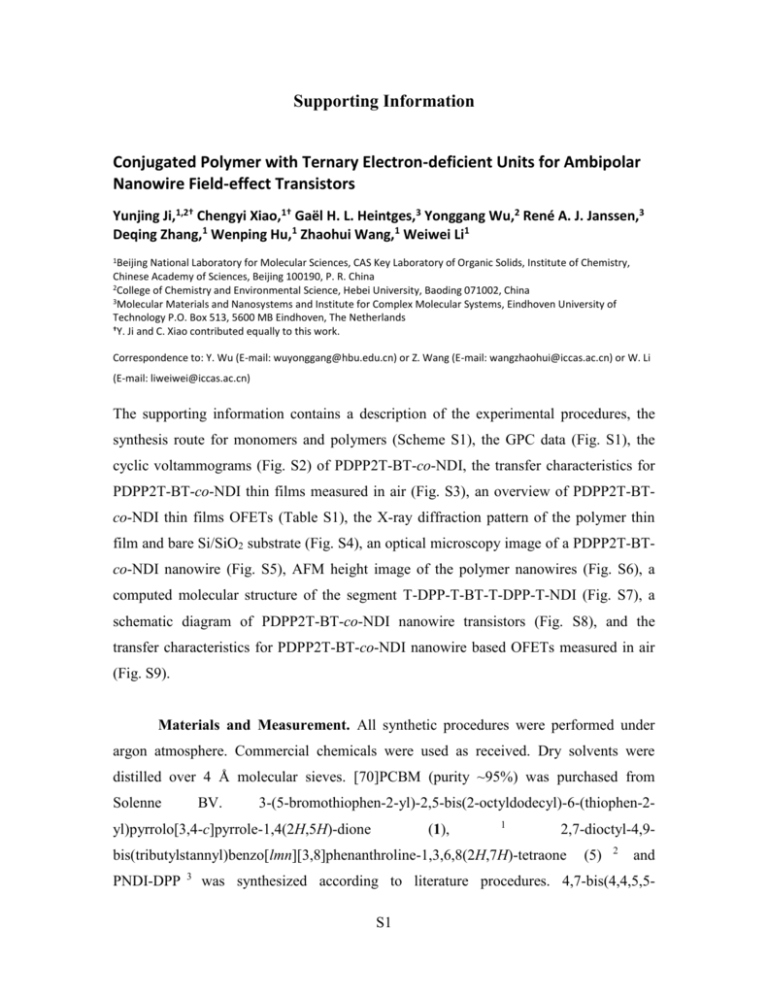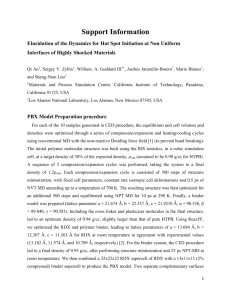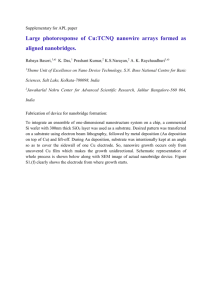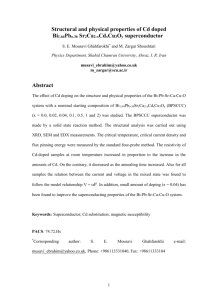pola27898-sup-0001-suppinfo01
advertisement

Supporting Information Conjugated Polymer with Ternary Electron-deficient Units for Ambipolar Nanowire Field-effect Transistors Yunjing Ji,1,2† Chengyi Xiao,1† Gaël H. L. Heintges,3 Yonggang Wu,2 René A. J. Janssen,3 Deqing Zhang,1 Wenping Hu,1 Zhaohui Wang,1 Weiwei Li1 1Beijing National Laboratory for Molecular Sciences, CAS Key Laboratory of Organic Solids, Institute of Chemistry, Chinese Academy of Sciences, Beijing 100190, P. R. China 2College of Chemistry and Environmental Science, Hebei University, Baoding 071002, China 3Molecular Materials and Nanosystems and Institute for Complex Molecular Systems, Eindhoven University of Technology P.O. Box 513, 5600 MB Eindhoven, The Netherlands †Y. Ji and C. Xiao contributed equally to this work. Correspondence to: Y. Wu (E-mail: wuyonggang@hbu.edu.cn) or Z. Wang (E-mail: wangzhaohui@iccas.ac.cn) or W. Li (E-mail: liweiwei@iccas.ac.cn) The supporting information contains a description of the experimental procedures, the synthesis route for monomers and polymers (Scheme S1), the GPC data (Fig. S1), the cyclic voltammograms (Fig. S2) of PDPP2T-BT-co-NDI, the transfer characteristics for PDPP2T-BT-co-NDI thin films measured in air (Fig. S3), an overview of PDPP2T-BTco-NDI thin films OFETs (Table S1), the X-ray diffraction pattern of the polymer thin film and bare Si/SiO2 substrate (Fig. S4), an optical microscopy image of a PDPP2T-BTco-NDI nanowire (Fig. S5), AFM height image of the polymer nanowires (Fig. S6), a computed molecular structure of the segment T-DPP-T-BT-T-DPP-T-NDI (Fig. S7), a schematic diagram of PDPP2T-BT-co-NDI nanowire transistors (Fig. S8), and the transfer characteristics for PDPP2T-BT-co-NDI nanowire based OFETs measured in air (Fig. S9). Materials and Measurement. All synthetic procedures were performed under argon atmosphere. Commercial chemicals were used as received. Dry solvents were distilled over 4 Å molecular sieves. [70]PCBM (purity ~95%) was purchased from Solenne BV. 3-(5-bromothiophen-2-yl)-2,5-bis(2-octyldodecyl)-6-(thiophen-2- yl)pyrrolo[3,4-c]pyrrole-1,4(2H,5H)-dione (1), 1 2,7-dioctyl-4,9- bis(tributylstannyl)benzo[lmn][3,8]phenanthroline-1,3,6,8(2H,7H)-tetraone PNDI-DPP 3 (5) 2 and was synthesized according to literature procedures. 4,7-bis(4,4,5,5S1 tetramethyl-1,3,2-dioxaborolan-2-yl)benzo[c][1,2,5]thiadiazole (2) was purchased from Sunatech Inc. and recrystallized from heptane before use. 1 H-NMR and 13 C-NMR spectra were recorded at 400 MHz and 100 MHz on a Bruker ANACE spectrometer with CDCl3 as the solvent and tetramethylsilane (TMS) as the internal standard. Molecular weight of PDPP2T-BT-co-NDIwas determined with GPC at 140 °C on a PL-GPC 220 system using a PL-GEL 10μm MIXED-B column and o-DCB as the eluent against polystyrene standards. A low concentration of 0.1 mg mL−1of polymer in o-DCB was used to reduce aggregation. UV-vis spectra were recorded on a JASCO v-570 spectrophotometer. Cyclic voltammetry was performed under an inert atmosphere with a scan rate of 0.1 V s−1 and 1 M tetrabutylammonium hexafluorophosphate in o-DCB as the electrolyte. The working, counter and reference electrodes were glassy carbon, Pt wire and Ag/AgCl, respectively. The concentration of the sample in the electrolyte was approximately 1 mM, based on monomers. All potentials were corrected against Fc/Fc+. X-Ray diffraction (XRD) measurements were obtained in reflection mode at 40 kV and 200 mA with Cu Kα radiation using a 2-kW Rigaku D/max-2500 X-ray diffractometer. Atomic force microscopy (AFM) images of films were obtained by using a Digital Instruments Nanoscope IIIa Multimode atomic force microscope in tapping mode. SEM images were obtained with a Hitachi S-4300 microscope (Japan), and TEM observation was carried out with a JEOL 1011 microscope. Bottom gate - bottom contact organic field-effect transistors were fabricated using heavily doped silicon wafers as the common gate electrode with a 300 nm thermally oxidized SiO2 layer, modified by OTS, as gate dielectric. Au (25 nm) electrodes were deposited in vacuum and subsequently polymer thin films were deposited by spin coating from a chloroform solution with thickness around 30 – 50 nm. The OFETs were then moved into a high vacuum chamber (~10-3 Pa) for thermal annealing at the desired temperature (120 °C, 140 °C, 160 °C, or 180 °C) for 2 hours. The devices were measured on an Agilent B1500 semiconductor parameter analyzer at room temperature. The mobility (μ) in the saturated region and the threshold voltage (VT) from transfer curves were calculated using IDS= (W/2L) Ciμ (VG – VT)2, where W and L are the channel width and length, respectively, Ci is the unit dimensional dielectric capacitance of gate insulator, μ is the field-effect mobility, and VT is the threshold voltage. S2 Polymer nanowires were fabricated by solvent vapor annealing from a dilute CHCl3 solution (0.01 mg/mL) in the presence of CHCl3 vapor in a closed jar.4 In detail, the OTS (octadecyltrichlorosilane) modified Si/SiO2 substrate (1.0×1.0 cm2) was put into a jar (20 mL). 2 mL CHCl3 was carefully injected into the jar to surround the substrate (Note: the solvent should not penetrate onto the top of the substrate). The polymer solution in CHCl3 (0.01 mg/ml) was then dropped on top of the substrate and the jar was sealed to slowly grow the polymer nanowire in 24 hours. Bottom gate – top contact OFETs based on the polymer nanowires were constructed on an OTS modified Si/SiO2 substrate (n-type Si wafer containing 300 nm-thick SiO2) using an “organic ribbon mask” technique. 5 Prior to the self-assembly of polymer nanowires, the OTS modified Si/SiO2 substrate was cleaned with hexane, chloroform, and ethanol. Then, polymer nanowires were produced on Si/SiO2 substrates through solvent vapor annealing. Subsequently, 40 nm thick source and drain electrodes were deposited on the nanowires by thermal evaporation with an organic ribbon as the mask. Electrical characteristics of the devices were recorded with a Keithley 4200-SCS semiconductor parameter analyzer and a Micromanipulator 6150 probe station in a glove box at room temperature. Synthesis. The synthetic route to DPP2T-BT-co-NDI is shown in Scheme S1. Scheme S1 Synthesis route of DPP based monomers and polymerization for PDPP2TBT-co-NDI. (i) Pd(PPh3)4/K2CO3 (aq)/Aliquat 336 in toluene at 80 °C. (ii) NBS in CHCl3. (iii) Stille polymerization by using Pd2(dba)3/PPh3/CuI in toluene/DMF (10:1, v/v) at 115 °C. Compound 3. To a degassed mixture of 3-(5-bromothiophen-2-yl)-2,5-bis(2octyldodecyl)-6-(thiophen-2-yl)pyrrolo[3,4-c]pyrrole-1,4(2H,5H)-dione S3 (1) (0.4 g, 0.42mmol), 4,7-bis(4,4,5,5-tetramethyl-1,3,2-dioxaborolan-2-yl)benzo[c][1,2,5]thia- diazole (2) (77.6mg, 0.2 mmol), 2 M K2CO3 in H2O (2 mL), toluene (10 mL),and Aliquat 336 (0.2 mL), was added tetrakis(triphenylphosphine)palladium(0) (26 mg, 22.5µmol). The mixture was stirred at 80 °C for 24 h. The resulting mixture was cooled to room temperature after which it was poured out in chloroform, washed by water and brine, and dried by evaporation. The resulting solid was subjected to column chromatography (silica, eluent heptane/CH2Cl2, 60%/40%) and then recrystallized from acetone/toluene (20 mL/2 mL) at 0 °C to afford 3 (0.38 g, 88%). 1H NMR δ (ppm): 9.09 (d, 2H), 8.93 (d, 2H), 8.18 (d, 2H), 8.02 (s, 2H), 7.62 (d, 2H), 7.27 (d, 2H), 4.09 (m, 8H), 1.98 (m, 4H), 1.45 – 1.1 (m, 112H), 0.83 (m, 24H).MS (MALDI): calculated, 1854.98; found, 1854.0 (M+). Compound 4. To a degassed solution of 3 (0.245g, 0.13 mmol) in chloroform (10 mL) at 0 °C, N-bromosuccinimide (48.4 mg, 0.27 mmol) was added in portions in 10 min, and the reaction mixture was stirred in another 2 hours at room temperature. After this the mixture was poured out in chloroform, washed with water and brine, and evaporated. The resulting solid was subjected to column chromatography (silica, eluent heptane/CH2Cl2, 60%/40%) and then recrystallized from acetone/toluene (20 mL/4 mL) at 0 °C to afford 4 (0.17 g, 62.6%).1H NMR δ (ppm): 9.05 (m, 2H), 8.66 (m, 2H), 8.02 (m, 2H), 7.77 (m, 2H), 7.13 (m, 2H), 4.08 (m, 4H), 3.93 (m, 4H), 1.98 (m, 4H), 1.45 – 1.1 (m, 112H), 0.86 (m, 24H). MS (MALDI): calculated, 2012.77; found, 2012.60 (M+). PDPP2T-BT-co-NDI. To a degassed solution of monomer 4 (108.46 mg, 0.054 mmol), 2,7-dioctyl-4,9-bis(tributylstannyl)benzo[lmn][3,8]phenanthroline- 1,3,6,8(2H,7H)-tetraone(5) (57.59 mg, 0.054 mmol) in toluene (3 mL) and DMF (0.3 mL), tris(dibenzylideneacetone)dipalladium(0) (1.48 mg, 1.6µmol),triphenylphosphine (1.696 mg, 6.5µmol), and CuI (2.05 mg, 0.011 mmol) were added. The mixture was stirred at 115 °C for 16 h, after which it was precipitated in methanol and filtered through a Soxhlet thimble. The polymer was extracted with acetone, hexane, dichloromethane, and then dissolved in 1,1,2,2-tetrachloroethane (TCE) (80 mL) at 140 °C, which was then precipitated into acetone. Finally the resulting polymer can be solubilized in chloroform for device fabrication. Yield: 120 mg (94.9%) as a dark solid. GPC (o-DCB, 140 °C): Mn = 100.9 kg mol-1, Mw = 277.7 kg mol-1, and PDI = 2.75. S4 Fig. S1 GPC recorded at 140 °C with o-DCB as eluent for PDPP2T-BT-co-NDI. a) -5 2.0x10 b) PDPP2T-BT-co-NDI -5 1.5x10 PNDI-DPP -5 1.0x10 -5 1.0x10 Current (A) Current (A) -6 5.0x10 0.0 -5 -1.0x10 -5 -2.0x10 0.0 -6 -5.0x10 -5 -1.0x10 -5 -1.5x10 -5 -3.0x10 -5 -2.0x10 -5 -4.0x10 -3.0 -2.5 -2.0 -1.5 -1.0 -0.5 0.0 0.5 1.0 1.5 -3 -2 Voltage (V) -1 0 1 2 Voltage (V) Fig. S2 Cyclic voltammogram of (a) PDPP2T-BT-co-NDI and (b) PNDI-DPP in o-DCB. Potential vs. Fc/Fc+. For PDPP2T-BT-co-NDI, extracted Ered was -0.95 eV. LUMO level is determined using a work function value of -5.23 eV for Fc/Fc+. HOMO level is determined as ELUMO – Egfilm. For PNDI-DPP, extracted Ered was -1.30 eV and Eox was 0.22 eV. The calculation of HOMO and LUMO can be seen in the ref. 6. Table S1. Overview of PDPP2T-BT-co-NDI thin films OFETs thermal annealing (TA) under different temperature and measured in inert atmosphere or in air. TA μh Condition (°C) (cm2 V-1s-1) In glove box 120 140 2.64×10-2 160 4.8×10-2 S5 μe (cm2 V-1s-1) 7.11×10-2 1.15×10-2 8.27×10-3 3.27×10-2 1.53×10-2 1.62×10-2 8.53×10-3 180 120 140 160 180 In air a) 5.73×10-3 8.41×10-4 3.58×10-4 - b) Vsd = -100 V 0.006 Vsd = 100 V 0.004 10-5 -5 10-6 0.002 10-6 -Isd (A) |Isd|1/2 (A1/2) 0.004 -Isd (A) |Isd|1/2 (A1/2) 10 0.002 10-7 10-7 10-8 0.000 0.000 10-8 -100 -80 -60 -40 -20 0 20 -20 0 20 40 60 80 100 Vg (V) Vg (V) Fig. S3 (a) p-type and (b) n-type transfer characteristics for PDPP2T-BT-co-NDI thin films based OFETs at optimized annealing temperatures with bottom contact configuration measured in air. a) b) 3 1.5x10 2000 Si/SiO substrate 2 RT 1500 Intensity (a.u.) Intensity (a.u.) 150 oC 3 1.0x10 2 5.0x10 1000 33 500 0.0 5 10 15 20 25 30 35 0 5 10 15 20 25 30 o 35 2 2 Fig. S4 X-ray diffraction patterns of (a) thin films of PDPP2T-BT-co-NDI without thermal annealing (black line) and with thermal annealing at 150 °C for 10 min (red line). The lamellar spacing is 20.8 Å and π-π stacking spacing is ~ 4.0 Å. (b) bare Si/SiO2 substrate. S6 Fig. S5 Optical microscopy image of PDPP2T-BT-co-NDI nanowire. Fig. S6 AFM height images of the polymer nanowire self-assembled on OTS treated Si/SiO2 substrates. The width and the height of the nanowire are ~ 790 nm and 85 nm. Fig. S7 Computed molecular structure of the segment T-DPP-T-BT-T-DPP-T-NDI based on the polymer PDPP2T-BT-co-NDI by density functional theory (DFT) calculations that were performed at the B3LYP/6-31G* level of theory by using the Gaussian 09 program package. (a) The calculated HOMO and LUMO levels; (b) front view and side view of S7 the segment. The length of the segment is calculated as 3.68 nm and the dihedral angle between DPP-T and NDI units is 42o. Fig. S8 Schematic diagram of PDPP2T-BT-co-NDI nanowire transistors. a) Vsd = -100 V 0.0016 10-6 0.0012 10-7 0.0012 10-7 0.0008 10-8 |Isd|1/2 (A1/2) 10-6 10-8 0.0008 -Isd (A) Vsd = 100 V 0.0016 -Isd (A) |Isd|1/2 (A1/2) 10-5 b) 10-9 0.0004 10-9 0.0004 10-10 0.0000 10-10 -100 -80 -60 -40 -20 0.0000 0 0 Vg (V) 20 40 60 80 100 10-11 Vg (V) Fig. S9 (a) p-type and (b) n-type transfer characteristics for PDPP2T-BT-co-NDI nanowire based OFETs with top contact configuration measured in air. 1 K. H. Hendriks, G. H. L. Heintges, V. S. Gevaerts, M. M. Wienk and R. A. J. Janssen, Angew. Chem., Int. Ed. 2013, 52, 8341-8344. S8 2 3 4 5 6 X. Zhang, C. Xiao, A. Zhang, F. Yang, h. dong, Z. Wang, X. Zhan, W. Li and W. Hu, Polym. Chem. 2015, 6, 4775-4783. P. Wang, H. Li, C. Gu, H. Dong, Z. Xu and H. Fu, Rsc Adv. 2015, 5, 19520-19527. H. Dong, S. Jiang, L. Jiang, Y. Liu, H. Li, W. Hu, E. Wang, S. Yan, Z. Wei, W. Xu and X. Gong, J. Am. Chem. Soc. 2009, 131, 17315-17320. L. Jiang, J. Gao, E. Wang, H. Li, Z. Wang, W. Hu and L. Jiang, Adv. Mater. 2008, 20, 2735-2740. D. Veldman, S. C. J. Meskers and R. A. J. Janssen, Adv. Funct. Mater. 2009, 19, 1939-1948. S9








